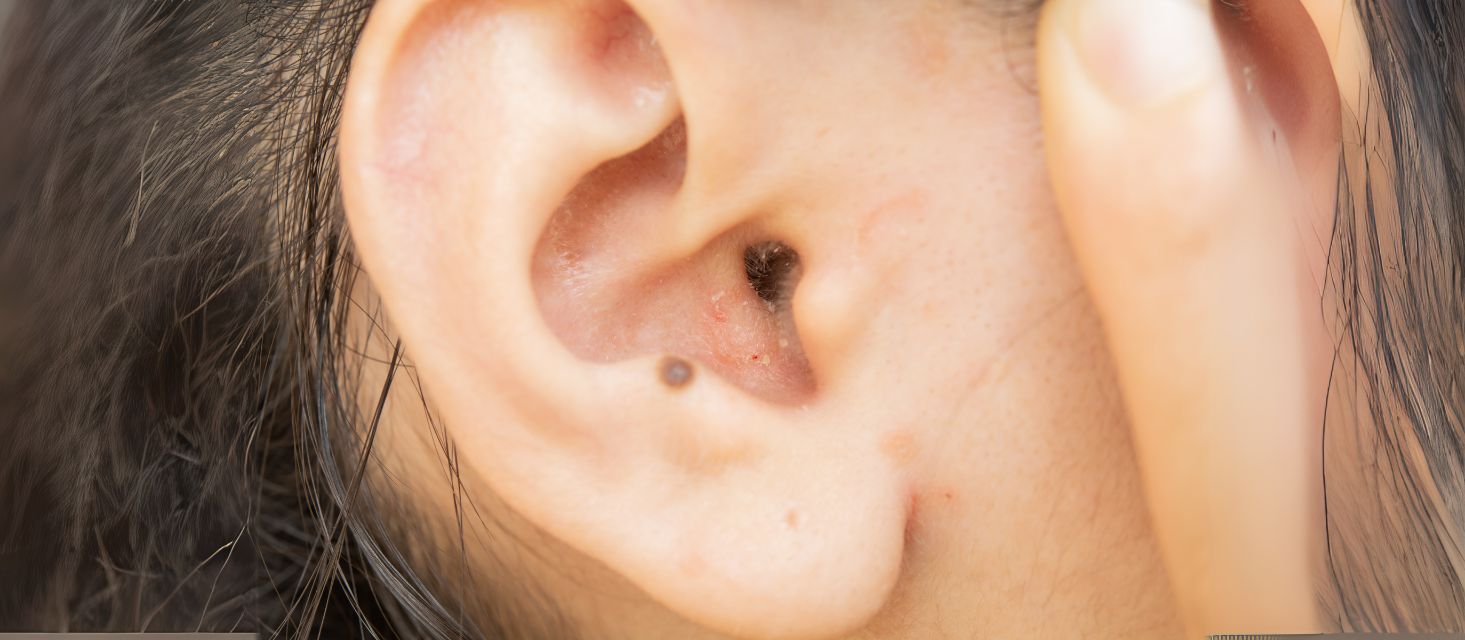We all know the struggle of dry skin, but when it shows up inside your ears? That’s a whole new level of irritating. Whether it’s flaky skin, intense itching, or dry patches behind the ear folds, dry skin inside ears can be more than uncomfortable—it can be downright disruptive.
At Auracle, we believe caring for your ears is just as important as the rest of your skin care routine. Let’s explore what causes dry skin in and around the ear canal, how to manage it, and how to prevent flare ups long term.
What Causes Dry Skin Inside Ears?
There’s no one-size-fits-all answer, but here are the most common triggers.
1. Skin Conditions (Like Eczema or Dermatitis)
Conditions such as ear eczema, seborrheic dermatitis, atopic eczema, and contact dermatitis can all affect the outer ear, ear folds, and even your inner ears.
-
Ear eczema often causes itchy skin, redness, scaling, and discomfort.
-
Seborrheic dermatitis usually appears as oily, flaky patches—especially around the scalp and ears.
-
Atopic dermatitis tends to be more common in people with sensitive skin or a family history of eczema.
-
Asteatotic eczema tends to appear more in older adults, particularly in colder months.
You can learn more in this ear eczema factsheet published by the British Association of Dermatologists.
Wondering if ear eczema contagious? It’s not. But it can still be persistent and irritating.
2. Environmental Triggers
-
Cold weather and dry air are major culprits, especially in winter.
-
Low humidity levels can strip moisture from your skin barrier.
-
Ultraviolet light exposure can dry out skin and lead to peeling.
3. Allergic Reactions
Sometimes, dry skin inside ears is your body’s way of responding to something it doesn’t like.
Common irritants:
-
Hair dye
-
Perm solution
-
Hearing aids
-
Nickel allergy (from pierced ears or jewellery)
-
Ingredients in soaps, shampoos, or face washes
4. Over-Cleaning and Improper Tools
Using cotton buds, cotton swabs, or other pointed objects to clean your ears can:
-
Break down the skin barrier function
-
Cause painful cracks or tiny tears
-
Lead to inflammation or even an ear infection
Hint: Skip the buds. Use tools like the Eddy to clean your ears with gentle suction and water pressure instead.
5. Infections and Inflammation
When dry skin is left untreated, it can turn into otitis externa (infection of the external ear). Other skin conditions like fungal infections may also be responsible if your ears are red, itchy, and producing discharge.
Sometimes the immune system overreacts, triggering inflammation that worsens existing eczema.
Symptoms of Dry Skin Inside Ears
You’ll likely notice:
-
Flaky skin or dry patches
-
More intense itching at night
-
Redness or inflammation
-
Burning or sensitivity when touched
-
Skin peeling around the ear hole or where ears meet the face
-
Hearing loss if the ear canal becomes blocked
In severe cases, cracks in the skin may sting or even bleed.
Risk Factors That Make Dry Ear Skin Worse
-
Having atopic eczema or a family history of allergies
-
Wearing hearing aids or having ears pierced
-
Frequent exposure to common allergens
-
Using scented products near your ears
-
Cleaning too aggressively
-
Living in areas with dry or cold climates
How to Treat Dry Skin Inside Ears
There’s no need to suffer. Many at home treatments can soothe symptoms and restore comfort—especially when caught early.
1. Gently Wash and Moisturise
Use warm water and a damp cloth to clean around the ear. Avoid soap directly inside. Apply a light moisturiser or ear-safe oil (like olive oil) around the area.
Avoid rubbing and avoid scratching—this can damage the skin and slow healing.
2. Switch Products
If you suspect an allergic reaction, try eliminating one product at a time (e.g., shampoo, hair dye, conditioner). Look for hypoallergenic, fragrance-free, and dermatologist-approved labels.
3. Ear Drops and Saline Rinses
Try using non-medicated ear drops or saline sachets to rinse the ear canal gently. This helps remove debris and calm inflammation.
4. Use Safe Cleaning Tools
For those with dry skin caused by excess earwax, the Eddy ear cleaner offers a safe, water-based way to remove wax without drying your ears out. Plus, it protects the skin barrier by avoiding physical scraping.
Grab some replacement tips and replacement reservoirs to keep things clean.
5. Apply Medicated Creams (If Prescribed)
-
Hydrocortisone cream or other topical steroids can help reduce inflammation
-
Prescription medications may be needed in severe cases
-
Your doctor may suggest antibiotic ointments or antifungal treatments depending on cause
Always follow your healthcare provider’s guidance and ask about the most appropriate antibiotics or steroid types for sensitive skin.
How to Prevent Flare-Ups and Keep Ears Healthy
Once you’ve treated the symptoms, here’s how to avoid future trouble:
-
Avoid scratching or picking at the skin
-
Don’t insert cotton buds or sharp objects
-
Keep ears dry after swimming or showering
-
Avoid wearing earrings if they cause irritation
-
Watch for signs of allergic eczema or contact dermatitis
-
Use gentle, fragrance-free personal care products
-
Keep a log of products or risk factors that may cause reactions
When to See a Healthcare Professional
Call your healthcare professional if:
-
Your symptoms persist beyond two weeks
-
You notice pus, severe pain, or swelling
-
You develop hearing loss or muffled sound
-
The dry skin spreads or worsens despite treatment
-
You suspect an ear infection or fungal infection
They may recommend:
-
Blood tests to rule out immune conditions
-
A referral to a dermatologist
-
Swabs to identify bacteria or yeast
-
Treatment guided by the Cleveland Clinic or national dermatology association guidelines
Conclusion: You Don’t Have to Live with Dry Ears
Dry skin inside ears isn’t just a minor nuisance—it can affect your comfort, your hearing, and even your confidence. But with the right self care, smart tools, and guidance from your healthcare provider, you can ease symptoms and prevent flare ups.
Whether it’s ear eczema, a bit of seborrheic dermatitis, or simply cold weather working against you, the team at Auracle is here to help you take care of your ears from the inside out.
Start with our Eddy ear cleaner for safe cleaning, and explore our saline sachets to maintain gentle hydration in the ear canal.
FAQs
How can I get rid of dry skin in my ears?
You’ll want to start with gentle cleansing using warm water and a soft cloth—skip soap inside the ear canal. Follow up with a light, non-fragranced moisturiser like olive oil or petroleum jelly applied around the outer ear. If symptoms persist, check with your healthcare professional to rule out skin conditions like ear eczema or seborrheic dermatitis.
How often should I clean my ears?
Ears are self-cleaning, so cleaning too often can do more harm than good. You should:
-
Wipe the outer ear with a damp cloth daily
-
Avoid using cotton buds inside the ear
-
If prone to wax build-up, clean with the Eddy weekly or as advised by your doctor
Here’s a full guide: When Should I Clean My Ears?
What causes dry ears inside?
Dry ears may be caused by:
-
Cold weather and dry air
-
Allergic reactions to hair or skin products
-
Overuse of cotton swabs or cleaning tools
-
Skin conditions like atopic dermatitis, seborrheic dermatitis, or eczema inside the ear
-
Poor skin barrier function due to over-cleaning
Can dry skin in the ears cause deafness?
Not directly. But in severe cases, dry skin can lead to inflammation or wax blockage that causes temporary hearing loss. If symptoms are affecting your hearing, get assessed to rule out an ear infection or impaction.
What does an ear infection look like?
An ear infection often includes:
-
Redness and swelling in or around the ear canal
-
Pain or sensitivity
-
Discharge (clear, yellow, or pus-like)
-
Pressure or hearing changes
You might also notice more intense itching in early stages. For a full breakdown, check out What Does an Infected Ear Look Like?








Share:
Related Blogs
Eardrum Itching: What’s Causing It and How to Find Relief
Safety Cotton Swab Ears: What You Need to Know Before You Clean